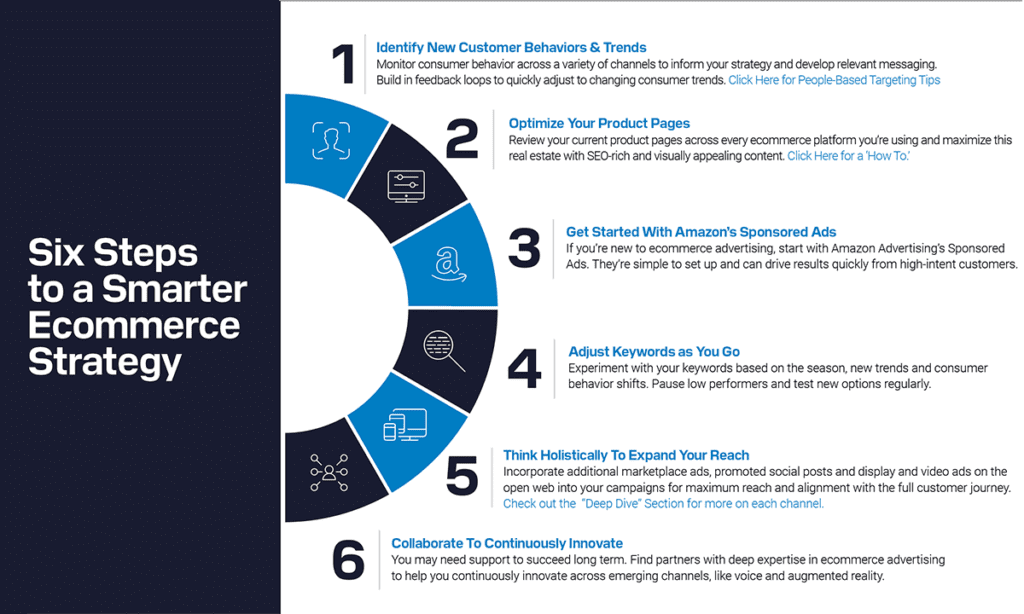6 Steps to a Smarter Ecommerce Advertising Strategy

Now more than ever, online shopping is a lifeline to everyday essentials for millions of people. From groceries to toys to school supplies, nearly every industry is trending upward in online growth. Marketers who are thinking of entering the ecommerce space – or who have already embraced it – must find a way to stand out from the crowd as so many brands battle for consumer attention in this unprecedented era. Luckily, we’re here to provide the insights and innovative thinking necessary to help you become a leader in today's online shopping marketplace. Start with these six steps to craft a smarter ecommerce advertising strategy:
1. Identify New Customer Behaviors and Trends
Since the pandemic, where consumers shop, what they spend their money on and how they choose the products and brands they purchase from have shifted. COVID-19 upset the usual balance, and experts anticipate these behaviors will continue to change long after the pandemic ends. Brands relying on past patterns or consumer behaviors to guide their advertising decisions will be at a disadvantage. However, for agile marketers, this means there are opportunities to re-evaluate shoppers’ needs and adjust their ecommerce advertising strategy to capture new market share.
While your core audience demographics may not change significantly, consumer attitudes, consumption trends and buying behaviors are very much still in flux. To target effectively, throw past playbooks out the window and build new buyer personas and a data strategy that will establish the right connection for the new normal. Monitor consumer behavior, needs and socioeconomic concerns across a variety of channels to inform your ecommerce advertising strategy and develop relevant messaging. Then build in feedback loops to adjust to changing consumer trends in real time.
2. Optimize Your Product Pages
Before you can begin advertising your online store, you must ensure your site and product pages are retail-ready. Creating a frictionless shopping experience throughout the entire funnel is key to motivating customers to browse, buy and come back often. Leverage a third-party ecommerce marketplace or build an ecommerce shopping platform into your site, such as Shopify, BigCommerce or 3dcart, to allow users to quickly browse and purchase your products online. Regularly review your product pages across every ecommerce platform you’re using and maximize this real estate with SEO-rich and visually appealing content to lay the foundation for a successful user experience.
3. Get Started With Amazon's Sponsored Ads
While there are many channels and platforms available to drive ecommerce activities, how much you invest in each channel relies heavily on your budget. For those new to ecommerce advertising, we recommend starting with Amazon’s Sponsored Product Ads. They’re simple to set up and because these ads are triggered by shoppers specifically searching for your product or similar products, your budget is optimized to only the highest-intent users. These placements can make a quick impact on your bottom line; then you can use the real-time data and results from that campaign to fund waterfall budgets with other publishers.
4. Adjust Keywords as You Go
Retail websites and search engines are generally query-based. That’s why it’s critical for marketers to make sure shoppers can find their brand and products with a strong organic and paid keyword strategy. Experiment with your keywords based on the season, new trends and consumer behavior shifts. Keep an open mind when creating your initial keyword list and gradually fine-tune it – pausing low performers as needed and continually testing new options.
5. Think Holistically to Expand Your Reach
As you begin to expand your ecommerce advertising plan, it’s important to remember that every marketing effort you implement has an impact on your other investments. And it’s through combining these efforts that you maximize effectiveness and create a virtuous customer cycle. So marketers must strive over time to create a holistic advertising strategy that incorporates additional marketplace ads, promoted social posts and display and video ads on the open web for maximum reach and alignment with the full customer journey.

6. Collaborate to Continuously Innovate
Competition is fierce in digital marketing. It’s not enough to rely on one platform or one tool in today’s environment. Long-term success requires the right resources and partners to take your ecommerce ad strategy to the next level. No matter what channels you’re advertising across, consider augmenting your program with a trusted partner or technology service that offers deep expertise or capabilities in ecommerce advertising to help you continuously innovate across emerging channels, like voice and augmented reality.

To get more tips for turning browsers into buyers, download our updated Ecommerce Advertising Playbook now. Or let our experts help you find the right advertising solutions for your business – reach out to us to schedule a complimentary ecommerce advertising analysis today.





